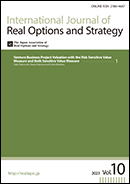Current issue
Displaying 1-2 of 2 articles from this issue
- |<
- <
- 1
- >
- >|
Theoretical Paper
-
2023 Volume 10 Pages 1-22
Published: 2023
Released on J-STAGE: December 25, 2023
Download PDF (211K)
Cover, Publisher
-
2023 Volume 10 Pages Cover00_1-EdBrd00_1
Published: 2023
Released on J-STAGE: December 25, 2023
Download PDF (466K)
- |<
- <
- 1
- >
- >|
